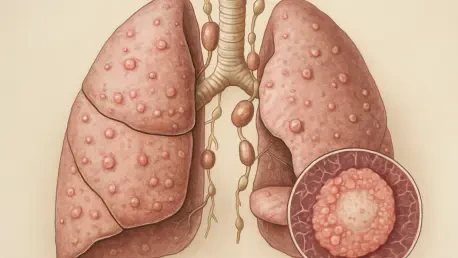Imagine living with a condition so elusive that it can hide within the body for decades, only to be discovered by chance during a routine test for something entirely unrelated, like a simple chest X-ray or blood panel. Sarcoidosis, a complex inflammatory disease, often operates under such stealth, forming clusters of immune cells known as granulomas that can affect vital organs like the lungs or lymph nodes. For many, the journey to diagnosis is fraught with confusion, as symptoms mimic other ailments or remain silent until a critical moment reveals the truth. This hidden nature makes sarcoidosis a medical enigma, challenging both patients and healthcare providers to piece together a puzzle with no clear picture. The disease’s ability to disguise itself underscores a pressing need for awareness and specialized care, as delayed recognition can lead to severe complications. By delving into personal stories and expert insights, a clearer understanding emerges of how this condition impacts lives and why unraveling its mysteries remains a priority in medical research.
Decoding the Mystery of Diagnosis
Navigating the path to identifying sarcoidosis often feels like solving an intricate riddle with no definitive answer. Unlike many conditions that can be confirmed with a single test, this disease requires a multifaceted approach, combining detailed imaging, specialized evaluations, and a thorough review of patient history. Physicians must rely heavily on their expertise to distinguish sarcoidosis from similar disorders, as its symptoms—ranging from persistent cough and shortness of breath to joint pain and skin abnormalities—can easily be mistaken for other illnesses. The diagnostic challenge is compounded by the fact that the condition may lie dormant for years, only surfacing during unrelated medical investigations. For some, misdiagnoses like lung cancer are a harrowing initial conclusion before the true nature of the disease is uncovered. This complexity highlights the critical role of experienced medical teams who can interpret subtle clues and tailor diagnostic strategies to each unique case, ensuring that patients receive accurate and timely answers to guide their treatment journey.
Tailoring Treatment and Embracing Resilience
Managing sarcoidosis demands a personalized approach, as the disease manifests differently across individuals and demographics, with no known cure to date. Treatment often focuses on controlling inflammation and alleviating symptoms, utilizing medications originally designed for other conditions to stabilize complications like high blood pressure in the lungs. Specialized programs at leading health institutions have become vital in offering targeted care, adapting strategies to the specific needs of each patient. Beyond clinical interventions, the human aspect of living with this chronic illness reveals profound resilience, as individuals adjust their lifestyles to maintain independence despite physical limitations. Research continues to explore why the disease progresses uniquely in each person, aiming to uncover patterns that could lead to better outcomes. Looking back, the collaborative efforts between patients and medical experts have shown that while challenges persist, adaptive measures and dedicated oversight enable many to lead fulfilling lives, paving the way for future advancements in understanding and managing this enigmatic condition.









